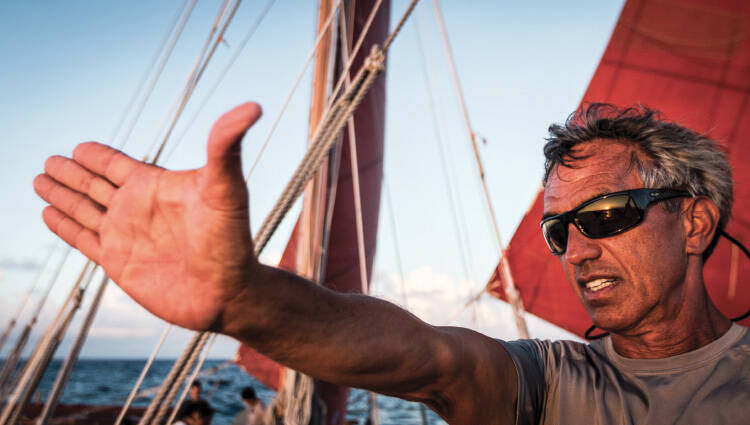A 43,000-mile voyage of the Pacific Ocean is the topic of this year’s Trudy Sundberg Lecture.
Titled “Finding Our Way, Moananuiákea, A Voyage for Earth,” the presentation will be led by Nainoa Thompson, who is known as the first Hawaiian in over 600 years to practice the ancient Polynesian art of navigation.
Thompson plans to speak at 7:30 p.m. on Saturday, May 6 at the Whidbey Island Center for the Arts in Langley. Seating is first come, first serve and doors open at 7 p.m. for the free event, which is presented in collaboration with the Sno-Isle Libraries Foundation. Overflow seating will be provided in the adjacent Zech Hall.
Like Sundberg, the Oak Harbor teacher and community leader whom the annual lecture commemorates, Thompson believes in the importance of educating the younger generation.
“It’s an honor to come to this special place in the world and spend time with the children of that area,” he said of Whidbey.
Thompson was a young person himself when he joined the crew of Hókúle`a, a double-hulled canoe that revived Polynesian voyaging and navigation traditions lost in the colonization and westernization of the Polynesian archipelagos. Launched in 1975, the canoe’s first voyage was from Hawaii to Tahiti.
“My whole life changed. It was focused and it had a dream, it mattered,” Thompson said. “It was tied to the ocean and my identity as a Hawaiian and it linked so many things together. It allowed me to be a part of something really special.”
Growing up on the island of Oahu, Thompson did not learn about Hawaiian culture or language in school because it was outlawed.
“My 13 years in K-12, we were taught nothing about where did our ancestors come from, who were they and how did they get here,” he said.
That changed with the launch of Hókúle`a, which inspired a shift towards the preservation of culture and language. Thompson has been sailing ever since then.
“Other than my family, it’s been the primary focus of my life,” he said.
In June, Thompson and his crew from the Polynesian Voyaging Society will set out on a journey spanning nearly four years that is known as Moananuiákea, which means “ocean of the great expanse.” The voyage circumnavigating the Pacific Ocean will span 43,000 miles and include 100 indigenous territories, 300 ports and 36 countries and archipelagoes.
While Thompson plans to be onboard some of the time, he is hopeful that the younger crew members will take the lead starting in the second or third year of the voyage. A total of 400 crew members from all around the world will take turns sailing Hókúle`a, which is 62 feet long and 24 feet wide.
In addition, Moananuiákea is happening without the use of western navigational tools. Instead, navigators use observations of nature to figure out where they are and where they’re headed.
“You only know where you are in this navigation system by memorizing where you come from,” Thompson said.
Navigators use a 4,000-year-old star compass, the passage of heavenly bodies, sunrises and sunsets to determine location.
“If you’re gonna memorize nature, you gotta stay awake,” Thompson said. “Our navigators are up 21, 22 hours a day.”
Navigating is easiest on a clear, starry night. Thompson said navigators use a total of 220 stars that they know by name.
Moananuiákea is the first time that Hókúle`a will be so far north, since the voyage begins in Yakutat, Alaska. Thompson acknowledged that while cloudy skies make for difficult navigation, it’s not the only challenge the crew might face.
“Our canoe is only 3 feet off the water,” Thompson said. “If you’re in Hawaii, you fall overboard, you just enjoy the day and go swim around. In Alaska, that’s not the same.”
Hókúle`a will likely pass through the Seattle area in August or September. The mission of the voyage is to develop young leaders and engage communities around the world to take part in navigating the earth towards a healthy, thriving future. For his presentation on Whidbey Island, Thompson plans to bring with him the youngest navigator, who is a woman.
“The Pacific people never had lines drawn on a map about separating the ocean. It’s always one body of water. With that in mind, the ocean doesn’t divide us. It connects us,” Thompson said. “Having us come from the Pacific Islands connecting with you folks in the Pacific Northwest … it’s something very important to do.”



